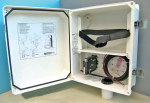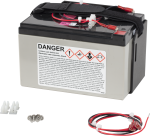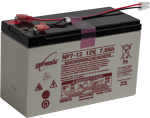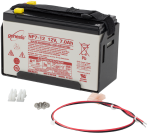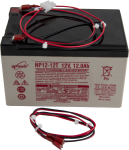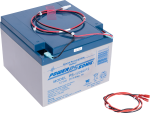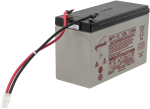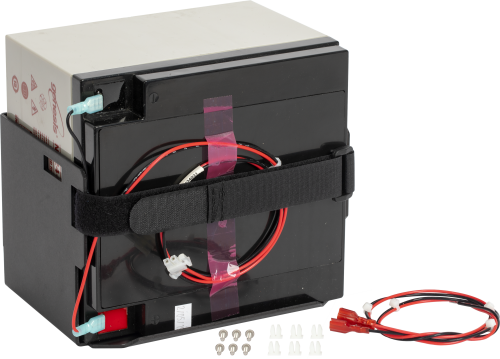
Overview
The BP24 is a rechargeable 12 Vdc, 24 Ah battery pack that can power a Campbell Scientific system. It is intended for high-current-drain systems, such as satellite transmitters, that require more power.
Read MoreImages

Similar Products
Detailed Description
The BP24 requires a regulated charging source (provided by the CH150 or CH200 regulator connected to an unregulated solar panel or a wall charger). The BP24 includes a 24 in. attached cable that terminates in a connector for attaching the battery to a CH150 or CH200 regulator. The BP24 also comes with a 24 in. cable for use with the CR6 datalogger or other products that need a pigtail termination instead of a white connector. (This cable is bagged and taped to the battery.) Switching the standard cable for the pigtail cable is easily accomplished by the user. The BP24 is shipped with a bracket that secures the BP24 to an enclosure backplate. An ENC16/18 enclosure is recommended.
Specifications
| -NOTE- | Usable length of the red and black power leads extends at least 20 cm (8 in.) past the white cable tie tab. |
| Battery Type | Sealed lead acid (SLA) |
| UL Approval File Number | MH16464 |
| Output Voltage | 12 Vdc |
| Nominal Rating | 24 Ah |
| Battery Cables Length | 0.6 m (2 ft) |
| Dimensions |
|
| Weight | 10.2 kg (22.4 lb) |
Compatibility
Documents
Videos & Tutorials
Frequently Asked Questions
Number of FAQs related to BP24: 12
Expand AllCollapse All
-
Campbell Scientific recommends keeping the BP24 in an enclosure to protect the terminal from rain and condensation that could short out the battery.
-
Data loggers require stable power supplies to work properly, such as the BP24. If the system is needed for a long-term application, recharge the battery frequently, or recharge it daily with a solar panel of the appropriate size.
-
No. The CH100 is designed to charge a 12 Vdc battery pack, not a 24 Vdc battery pack.
-
Check with the airline. Mention that the BP24 is a sealed, valve-regulated VRLA AGM battery.
-
Not quite. The PS24 consists of a 24 Ah battery, a CH100 regulator, and a 10 by 12 in. environmental enclosure. Aside from the enclosure, the PS24 is very similar to a BP24 combined with a CH100.
-
-
The discrepancy is not a mistake—the bracket is intentionally designed to be shorter than the battery. When mounted inside an enclosure, the back of the battery rests against the mounting grommets. The lid to the mounting bracket compresses the battery slightly, holding the battery firmly in place.
-
We do not offer a battery test kit. However, the CH200 charge regulator does have some features that could aid in discovering a bad battery, such as the ability to measure amperage into and out of the battery. Campbell Scientific recommends taking a voltmeter into the field to verify the battery voltage at different points to see if a dirty or corroded connection is causing a voltage drop in the system.
-
The BP24 should never be connected directly to an unregulated solar panel. A voltage regulator, such as the CH100, must be included in the circuit, or damage to the battery will occur.
-
Look for a stamp on top of the battery. The stamp may be in a date format of YYMMDDXX where:
- YY is the year.
- MM is the month.
- DD is the day.
- XX is the manufacturing plant.
This indicates the age of the battery.
Listed Under
Privacy Policy Update
We've updated our privacy policy. Learn More
Cookie Consent
Update your cookie preferences. Update Cookie Preferences
